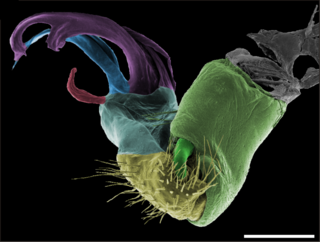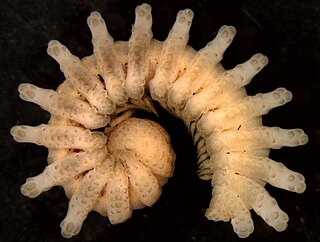
Millipedes are a group of arthropods that are characterised by having two pairs of jointed legs on most body segments; they are known scientifically as the class Diplopoda, the name derived from this feature. Each double-legged segment is a result of two single segments fused together. Most millipedes have very elongated cylindrical or flattened bodies with more than 20 segments, while pill millipedes are shorter and can roll into a tight ball. Although the name "millipede" derives from Latin for "thousand feet", no species was known to have 1,000 or more until the discovery in 2020 of Eumillipes persephone, which can have over 1,300 legs. There are approximately 12,000 named species classified into 16 orders and around 140 families, making Diplopoda the largest class of myriapods, an arthropod group which also includes centipedes and other multi-legged creatures.

Gonopods are specialized appendages of various arthropods used in reproduction or egg-laying. In males, they facilitate the transfer of sperm from male to female during mating, and thus are a type of intromittent organ. In crustaceans and millipedes, gonopods are modified walking or swimming legs. Gonopods may be highly decorated with elaborate structures which may play roles in sperm competition, and can be used to differentiate and identify closely related species. Gonopods generally occur in one or more pairs, as opposed to the single (un-paired) reproductive organs such as the aedeagus of insects or the penis of harvestmen.

Harpaphe haydeniana, commonly known as the yellow-spotted millipede, almond-scented millipede or cyanide millipede, is a species of polydesmidan ("flat-backed") millipede found in the moist forests along the Pacific coast of North America, from Southeast Alaska to California. The dark coloration with contrasting yellow-tipped keels warn of its ability to exude toxic hydrogen cyanide as a defense. The cyanide secretions are not dangerous to humans, but can cause irritation and pain if it contacts sensitive areas such as the mouth, eyes, or nose.

An ozopore is the opening of a defensive gland present in some arthropods, notably in millipedes of the order Polydesmida and in harvestmen, the eight-legged arachnids also known as "daddy long-legs". The glands themselves are known as ozadenes, also called "scent glands", "repugnatorial glands", "odoriferous glands" or "stink glands" by various authors. The name is derived from Ancient Greek ozo "smell" and Latin porus "pore, small opening".

Polydesmida is the largest order of millipedes, containing approximately 3,500 species, including all the millipedes reported to produce hydrogen cyanide (HCN). Polydesmids grow and develop through a series of moults, adding segments until they reach a fixed number in the adult stage, which is usually the same for a given sex in a given species, at which point the moulting and the addition of segments and legs stop. This mode of development, known as teloanamorphosis, distinguishes this order from most other orders of millipedes, which usually continue to moult as adults, developing through either euanamorphosis or hemianamorphosis.

Xystodesmidae is a family of millipedes. Its members often have very small distributional areas, with many species only known from a single locality. They are found across the northern hemisphere, with peak diversity in the Appalachian Mountains, where one-third of the 300 or so species occur. They are particularly abundant in deciduous broadleaf forests in the Mediterranean Basin, Africa, Asia, Central and North America, and Russia. Information on basic taxonomy is scant for this family; for example, it is estimated that the genus Nannaria contains over 200 species, but only 25 were described as of 2006. By 2022, 78 species in Nannaria have been described.

Leptodesmidea is a suborder of flat-backed millipedes under the order Polydesmida.
Tridontomidae is a small family of millipedes. Its members are endemic to Guatemala. These millipedes range from 22 mm to 28 mm in length and are uniformly grayish in color; their legs and antennae are unusually long and slender. This family includes the remarkable species Aenigmopus alatus, in which adult males feature no gonopods. This millipede is the only species in the infraclass Helminthomorpha without gonopods.

Motyxia is a genus of cyanide-producing millipedes that are endemic to the southern Sierra Nevada, Tehachapi, and Santa Monica mountain ranges of California. Motyxias are blind and produce the poison cyanide, like all members of the Polydesmida. All species have the ability to glow brightly: some of the few known instances of bioluminescence in millipedes.

Dalodesmidae is a family of millipedes in the order Polydesmida, containing at least 250 species found in the Southern Hemisphere.

Harold Frederick Loomis was an American botanist and myriapodologist known for his contributions to agronomy, plant pathology, and millipede taxonomy. He worked for the U.S. Department of Agriculture for over four decades, studying diseases of crop plants, and was a colleague of Orator F. Cook. He also made major contributions to the natural history of Central America and the West Indies, naming over 500 species of millipedes in total. He co-described with Cook the leggiest animal on earth: Illacme plenipes, with over 700 legs.

The moss millipede is a keeled millipede of the family Platyrhacidae native to Colombia. It was described in 2011, and with several species of symbiotic moss found growing on its dorsal surface, it is the first millipede known with epizoic plants.

Platyrhacidae is a family of polydesmidan millipedes distributed in Southeast Asia and tropical Central and South America.

Haplodesmidae is a family of millipedes in the order Polydesmida. Species occur in East Asia, Southeast Asia, and Oceania, although some species have been introduced to the New world tropics. Species are small bodied, often with elaborate sculpturing on the tergites, and some species are capable of rolling into a near-complete ball.

Ammodesmidae is a family of small millipedes endemic to Africa, containing seven species in two genera. Ammodesmids range from 1.4 to 5.0 mm long with 18 or 19 body segments in both sexes, and are capable of rolling into a tight sphere.

Chamberlinius is a genus of flat-backed millipedes in the family Paradoxosomatidae. There are five species; 3 of which occur only Taiwan, one only in the Ryukyu Islands of southeast Japan, and one occurring in both areas. Individuals are 25–37 mm (0.98–1.46 in) long and up to 5.5 mm wide, colored in pale yellow to brown, sometimes with dark brown markings on the anterior portion of body segments.
Tonkinosoma tiani, is a species of millipede belonging to the family Paradoxosomatidae. It is found from caves in southern China.

Cherokia Chamberlin, 1949 is a genus consisting of a single species, Cherokia georgiana. Commonly known as the wrinkled flat-backed millipede, this species belongs to the order Polydesmida and the family Xystodesmidae. It inhabits forests in the southeastern United States, particularly those with hemlock, maple, tulip poplar, rhododendron, cedar, and spruce-fir trees.
Pandirodesmus is a genus of flat-backed millipedes in the family Chelodesmidae, occurring in Trinidad and Tobago and Guyana. They are characterized by a lightly sclerotized, smooth, greyish-white exoskeleton and alternating long and short legs, exposed parts usually covered with densely cemented, but loosely attached sand grains imparting a dark beige to black coloration and concealing setae.

Heterocladosoma bifalcatum is a common species of millipede found in eastern Australia.

















